Application of Metabolomics in Fungal Research
Abstract
1. Introduction
2. Fungal Metabolomic Approaches
2.1. Rapid Sampling
2.2. Quenching
2.3. Sample Extraction
2.4. Instrumental Analysis Methods
2.5. Data Processing and Analysis Methods
3. Application of Metabolomics in the Field of Fungal Research
3.1. Application of Metabolomics in Classification and Identification of Fungal Research
3.2. Application of Metabolomics in the Study of Fungal Response to Stress
3.3. Application of Metabolomics in the Discovery of Fungal Metabolites
3.4. Application of Metabolomics in Fungal Metabolic Engineering
3.5. Application of Metabolomics in the Field of Plant–Fungal Interaction
4. Conclusions
Author Contributions
Funding
Conflicts of Interest
Abbreviations
References
- Devaux, P.G.; Horning, M.G.; Horning, E.C. Benzyloxime Derivatives of Steroids. A New Metabolic Profile Procedure for Human Urinary Steroids Human Urinary Steroids. Anal. Lett. 1971, 4, 151–160. [Google Scholar] [CrossRef]
- Oliver, S.G.; Winson, M.K.; Kell, D.B.; Baganz, F. Systematic functional analysis of the yeast genome. Trends Biotechnol. 1998, 16, 373–378. [Google Scholar] [CrossRef]
- Nicholson, J.K.; Lindon, J.C.; Holmes, E. ‘Metabonomics’: Understanding the metabolic responses of living systems to pathophysiological stimuli via multivariate statistical analysis of biological NMR spectroscopic data. Xenobiotica 1999, 29, 1181–1189. [Google Scholar] [CrossRef] [PubMed]
- Roberts, L.D.; Souza, A.L.; Gerszten, R.E.; Clish, C.B. Targeted Metabolomics. Curr. Protoc. Mol. Biol. 2012, 98, 30.2.1–30.2.24. [Google Scholar] [CrossRef] [PubMed]
- Patti, G.J.; Yanes, O.; Siuzdak, G. Innovation: Metabolomics: The apogee of the omics trilogy. Nat. Rev. Mol. Cell Biol. 2012, 13, 263–269. [Google Scholar] [CrossRef]
- Fiehn, O.; Kopka, J.; Trethewey, R.N.; Willmitzer, L. Identification of uncommon plant metabolites based on calculation of elemental compositions using gas chromatography and quadrupole mass spectrometry. Anal. Chem. 2000, 72, 3573–3580. [Google Scholar] [CrossRef]
- Nicholson, J.K.; Wilson, I.D. Opinion: Understanding ‘global’ systems biology: Metabonomics and the continuum of metabolism. Nat. Rev. Drug Discov. 2003, 2, 668–676. [Google Scholar] [CrossRef]
- Fernie, A.R.; Trethewey, R.N.; Krotzky, A.J.; Willmitzer, L. Metabolite profiling: From diagnostics to systems biology. Nat. Rev. Mol. Cell Biol. 2004, 5, 763–769. [Google Scholar] [CrossRef] [PubMed]
- Sumner, L.; Mendes, P.; Dixon, R. Plant Metabolomics: Large-Scale Phytochemistry in the Functional Genomics Era. Phytochemistry 2003, 62, 817–836. [Google Scholar] [CrossRef]
- Taylor, D.L.; Hollingsworth, T.N.; McFarland, J.W.; Lennon, N.J.; Nusbaum, C.; Ruess, R.W. A first comprehensive census of fungi in soil reveals both hyperdiversity and fine-scale niche partitioning. Ecol. Monogr. 2014, 84, 3–20. [Google Scholar] [CrossRef]
- Fisher, M.C.; Gow, N.A.R.; Gurr, S.J. Tackling emerging fungal threats to animal health, food security and ecosystem resilience. Philos. Trans. R. Soc. B Biol. Sci. 2016, 371, 20160332. [Google Scholar] [CrossRef] [PubMed]
- Fisher, M.C.; Henk, D.A.; Briggs, C.J.; Brownstein, J.S.; Madoff, L.C.; McCraw, S.L.; Gurr, S.J. Emerging fungal threats to animal, plant and ecosystem health. Nature 2012, 484, 186–194. [Google Scholar] [CrossRef] [PubMed]
- Tang, J. Microbial Metabolomics. Curr. Genom. 2011, 12, 391–403. [Google Scholar] [CrossRef] [PubMed]
- Mashego, M.R.; Rumbold, K.; De Mey, M.; Vandamme, E.; Soetaert, W.; Heijnen, J.J. Microbial metabolomics: Past, present and future methodologies. Biotechnol. Lett. 2007, 29, 1–16. [Google Scholar] [CrossRef]
- Kluger, B.; Lehner, S.; Schuhmacher, R. Metabolomics and Secondary Metabolite Profiling of Filamentous Fungi. In Biosynthesis and Molecular Genetics of Fungal Secondary Metabolites; Zeilinger, S., Martín, J.-F., García-Estrada, C., Eds.; Springer: New York, NY, USA, 2015; Volume 2, pp. 81–101. [Google Scholar]
- Keller, N.P. Fungal secondary metabolism: Regulation, function and drug discovery. Nat. Rev. Microbiol. 2019, 17, 167–180. [Google Scholar] [CrossRef]
- Chen, F.; Ma, R.; Chen, X.-L. Advances of Metabolomics in Fungal Pathogen–Plant Interactions. Metabolites 2019, 9, 169. [Google Scholar] [CrossRef]
- Jewett, M.C.; Hofmann, G.; Nielsen, J. Fungal metabolite analysis in genomics and phenomics. Curr. Opin. Biotechnol. 2006, 17, 191–197. [Google Scholar] [CrossRef]
- Silva, C.; Raisa Barbosa Cunha, J.; Almeida Conceição, A.; Gonzaga Almeida, E.; Cunha Zied, D.; Gonçalves Vieira Junior, W.; Souza Dias, E.; Isikhuemhen, O.S.; Verardi Abdelnur, P.; Gonçalves de Siqueira, F. Outdoor versus indoor cultivation: Effects on the metabolite profile of Agaricus subrufescens strains analyzed by untargeted metabolomics. Food Chem. 2022, 374, 131740. [Google Scholar] [CrossRef]
- Miura, D.; Tanaka, H.; Wariishi, H. Metabolomic differential display analysis of the white-rot basidiomycete Phanerochaete chrysosporium grown under air and 100% oxygen. FEMS Microbiol. Lett. 2004, 234, 111–116. [Google Scholar] [CrossRef][Green Version]
- Lu, Y.; Che, J.; Xu, X.; Pang, B.; Zhao, X.; Liu, Y.; Shi, J. Metabolomics Reveals the Response of the Phenylpropanoid Biosynthesis Pathway to Starvation Treatment in the Grape endophyte sp. MG1. J. Agric. Food Chem. 2020, 68, 1126–1135. [Google Scholar] [CrossRef]
- Sun, T.; Li, X.; Song, W.; Yu, S.; Wang, L.; Ding, C.; Xu, Y. Metabolomic alterations associated with copper stress in Cryptococcus neoformans. Future Microbiol. 2021, 16, 305–316. [Google Scholar] [CrossRef] [PubMed]
- Yan, Z.; Zhao, M.; Wu, X.; Zhang, J. Metabolic Response of to Continuous Heat Stress. Front. Microbiol. 2019, 10, 3148. [Google Scholar] [CrossRef] [PubMed]
- Zhao, X.; Chen, M.; Li, Z.; Zhao, Y.; Yang, H.; Zha, L.; Yu, C.; Wu, Y.; Song, X. The Response of to Low-Temperature Stress Based on Metabonomics. Front. Microbiol. 2020, 11, 1787. [Google Scholar] [CrossRef] [PubMed]
- Xie, Y.; Sun, X.; Feng, Q.; Luo, H.; Wassie, M.; Amee, M.; Amombo, E.; Chen, L. Comparative physiological and metabolomic analyses reveal mechanisms of Aspergillus aculeatus-mediated abiotic stress tolerance in tall fescue. Plant Physiol. Biochem. PPB 2019, 142, 342–350. [Google Scholar] [CrossRef]
- Zhang, S.-B.; Qin, Y.-L.; Li, S.-F.; Lv, Y.-Y.; Zhai, H.-C.; Hu, Y.-S.; Cai, J.-P. Antifungal mechanism of 1-nonanol against Aspergillus flavus growth revealed by metabolomic analyses. Appl. Microbiol. Biotechnol. 2021, 105, 7871–7888. [Google Scholar] [CrossRef]
- Perdigão Cota de Almeida, S.; Rozas, E.E.; Oller do Nascimento, C.A.; Dias, M.; Mendes, M.A. Metabolomic and secretomic approach to the resistance features of the fungus Aspergillus niger IOC 4687 to copper stress. Met. Integr. Biomet. Sci. 2021, 13, mfaa010. [Google Scholar] [CrossRef]
- Vinayavekhin, N.; Kongchai, W.; Piapukiew, J.; Chavasiri, W. Aspergillus niger upregulated glycerolipid metabolism and ethanol utilization pathway under ethanol stress. Microbiologyopen 2020, 9, e00948. [Google Scholar] [CrossRef]
- Jiang, A.-L.; Liu, Y.-N.; Liu, R.; Ren, A.; Ma, H.-Y.; Shu, L.-B.; Shi, L.; Zhu, J.; Zhao, M.-W. Integrated Proteomics and Metabolomics Analysis Provides Insights into Ganoderic Acid Biosynthesis in Response to Methyl Jasmonate in. Int. J. Mol. Sci. 2019, 20, 6116. [Google Scholar] [CrossRef]
- Soboń, A.; Szewczyk, R.; Rozalska, S.; Dlugonski, J. Metabolomics of the recovery of the filamentous fungus Cunninghamella echinulata exposed to tributyltin. Int. Biodeterior. Biodegrad. 2018, 127, 130–138. [Google Scholar] [CrossRef]
- Li, Z.; Ling, X.; Zhou, H.; Meng, T.; Zeng, J.; Hang, W.; Shi, Y.; He, N. Screening chemical modulators of benzoic acid derivatives to improve lipid accumulation in SR21 with metabolomics analysis. Biotechnol. Biofuels 2019, 12, 209. [Google Scholar] [CrossRef]
- Lu, L.; Zhu, K.-X.; Yang, Z.; Guo, X.-N.; Xing, J.-J. Metabolomics analysis of freeze-thaw tolerance enhancement mechanism of ε-poly-l-lysine on industrial yeast. Food Chem. 2022, 382, 132315. [Google Scholar] [CrossRef] [PubMed]
- Mishra, J.; Bhardwaj, A.; Pal, M.; Rajput, R.; Misra, K. High performance thin layer chromatography hyphenated with electrospray mass spectrometry for evaluation of nucleobases in two traditional Chinese medicinal mushrooms: A metabolomic approach. J. Liq. Chromatogr. Relat. Technol. 2018, 41, 910–918. [Google Scholar] [CrossRef]
- Joshi, R.; Sharma, A.; Thakur, K.; Kumar, D.; Nadda, G. Metabolite analysis and nucleoside determination using reproducible UHPLC-Q-ToF-IMS in Ophiocordyceps sinensis. J. Liq. Chromatogr. Relat. Technol. 2018, 41, 927–936. [Google Scholar] [CrossRef]
- Oh, J.; Yoon, D.-H.; Shrestha, B.; Choi, H.-K.; Sung, G.-H. Metabolomic profiling reveals enrichment of cordycepin in senescence process of Cordyceps militaris fruit bodies. J. Microbiol. 2019, 57, 54–63. [Google Scholar] [CrossRef]
- Chen, L.; Liu, Y.; Guo, Q.; Zheng, Q.; Zhang, W. Metabolomic comparison between wild Ophiocordyceps sinensis and artificial cultured Cordyceps militaris. Biomed. Chromatogr. BMC 2018, 32, e4279. [Google Scholar] [CrossRef]
- Liu, Y.; Xiao, K.; Wang, Z.; Wang, S.; Xu, F. Comparison of metabolism substances in Cordyceps sinensis and Cordyceps militaris cultivated with tussah pupa based on LC-MS. J. Food Biochem. 2021, 45, e13735. [Google Scholar] [CrossRef]
- Choi, J.N.; Kim, J.; Lee, M.Y.; Park, D.K.; Hong, Y.-S.; Lee, C.H. Metabolomics revealed novel isoflavones and optimal cultivation time of Cordyceps militaris fermentation. J. Agric. Food Chem. 2010, 58, 4258–4267. [Google Scholar] [CrossRef]
- Yao, L.; Zhu, L.-P.; Xu, X.-Y.; Tan, L.-L.; Sadilek, M.; Fan, H.; Hu, B.; Shen, X.-T.; Yang, J.; Qiao, B.; et al. Discovery of novel xylosides in co-culture of basidiomycetes Trametes versicolor and Ganoderma applanatum by integrated metabolomics and bioinformatics. Sci. Rep. 2016, 6, 33237. [Google Scholar] [CrossRef]
- Liu, Z.; Kang, B.; Duan, X.; Hu, Y.; Li, W.; Wang, C.; Li, D.; Xu, N. Metabolomic profiles of the liquid state fermentation in co-culture of A. oryzae and Z. rouxii. Food Microbiol. 2022, 103, 103966. [Google Scholar] [CrossRef]
- Cai, Z.-X.; Chen, M.-Y.; Lu, Y.-P.; Guo, Z.-J.; Zeng, Z.-H.; Liao, J.-H.; Zeng, H. Metabolomics and transcriptomics unravel the mechanism of browning resistance in Agaricus bisporus. PLoS ONE 2022, 17, e0255765. [Google Scholar] [CrossRef]
- Fu, Y.; Yu, Y.; Tan, H.; Wang, B.; Peng, W.; Sun, Q. Metabolomics reveals dopa melanin involved in the enzymatic browning of the yellow cultivars of East Asian golden needle mushroom (Flammulina filiformis). Food Chem. 2022, 370, 131295. [Google Scholar] [CrossRef] [PubMed]
- El-Hawary, S.S.; Mohammed, R.; Bahr, H.S.; Attia, E.Z.; El-Katatny, M.H.; Abelyan, N.; Al-Sanea, M.M.; Moawad, A.S.; Abdelmohsen, U.R. Soybean-associated endophytic fungi as potential source for anti-COVID-19 metabolites supported by docking analysis. J. Appl. Microbiol. 2021, 131, 1193–1211. [Google Scholar] [CrossRef] [PubMed]
- Zhao, X.; Hengchao, E.; Dong, H.; Zhang, Y.; Qiu, J.; Qian, Y.; Zhou, C. Combination of untargeted metabolomics approach and molecular networking analysis to identify unique natural components in wild Morchella sp. by UPLC-Q-TOF-MS. Food Chem. 2022, 366, 130642. [Google Scholar] [CrossRef] [PubMed]
- Le, V.-T.; Bertrand, S.; Robiou du Pont, T.; Fleury, F.; Caroff, N.; Bourgeade-Delmas, S.; Gentil, E.; Logé, C.; Genta-Jouve, G.; Grovel, O. Untargeted Metabolomics Approach for the Discovery of Environment-Related Pyran-2-ones Chemodiversity in a Marine-Sourced. Mar. Drugs 2021, 19, 378. [Google Scholar] [CrossRef]
- Huang, B.; Zeng, H.; Dong, L.; Li, Y.; Sun, L.; Zhu, Z.; Chai, Y.; Chen, W. Metabolite target analysis of isoprenoid pathway in Saccharomyces cerevisiae in response to genetic modification by GC-SIM-MS coupled with chemometrics. Metabolomics 2011, 7, 134–146. [Google Scholar] [CrossRef]
- Albright, J.C.; Henke, M.T.; Soukup, A.A.; McClure, R.A.; Thomson, R.J.; Keller, N.P.; Kelleher, N.L. Large-scale metabolomics reveals a complex response of Aspergillus nidulans to epigenetic perturbation. ACS Chem. Biol. 2015, 10, 1535–1541. [Google Scholar] [CrossRef]
- Alves, P.C.; Hartmann, D.O.; Núñez, O.; Martins, I.; Gomes, T.L.; Garcia, H.; Galceran, M.T.; Hampson, R.; Becker, J.D.; Silva Pereira, C. Transcriptomic and metabolomic profiling of ionic liquid stimuli unveils enhanced secondary metabolism in Aspergillus nidulans. BMC Genom. 2016, 17, 284. [Google Scholar] [CrossRef]
- Nguyen, P.-A.; Strub, C.; Lagrée, M.; Bertrand-Michel, J.; Schorr-Galindo, S.; Fontana, A. Study of in vitro interaction between Fusarium verticillioides and Streptomyces sp. using metabolomics. Folia Microbiol. 2020, 65, 303–314. [Google Scholar] [CrossRef]
- Smith, J.E.; Lay, J.O.; Bluhm, B.H. Metabolic fingerprinting reveals a new genetic linkage between ambient pH and metabolites associated with desiccation tolerance in Fusarium verticillioides. Metabolomics 2012, 8, 376–385. [Google Scholar] [CrossRef]
- Adpressa, D.A.; Connolly, L.R.; Konkel, Z.M.; Neuhaus, G.F.; Chang, X.L.; Pierce, B.R.; Smith, K.M.; Freitag, M.; Loesgen, S. A metabolomics-guided approach to discover Fusarium graminearum metabolites after removal of a repressive histone modification. Fungal Genet. Biol. FG B 2019, 132, 103256. [Google Scholar] [CrossRef]
- Liu, C.; Chen, F.; Zhang, J.; Liu, L.; Lei, H.; Li, H.; Wang, Y.; Liao, Y.-C.; Tang, H. Metabolic Changes of Fusarium graminearum Induced by Gene Deletion. J. Proteome Res. 2019, 18, 3317–3327. [Google Scholar] [CrossRef] [PubMed]
- Kalampokis, I.F.; Kapetanakis, G.C.; Aliferis, K.A.; Diallinas, G. Multiple nucleobase transporters contribute to boscalid sensitivity in Aspergillus nidulans. Fungal Genet. Biol. FG B 2018, 115, 52–63. [Google Scholar] [CrossRef] [PubMed]
- Lacerda, J.W.F.; Siqueira, K.A.; Vasconcelos, L.G.; Bellete, B.S.; Dall’Oglio, E.L.; Sousa Junior, P.T.; Faraggi, T.M.; Vieira, L.C.C.; Soares, M.A.; Sampaio, O.M. Metabolomic Analysis of Combretum lanceolatum Plants Interaction with Diaporthe phaseolorum and Trichoderma spirale Endophytic Fungi through H-NMR. Chem. Biodiversity 2021, 18, e2100350. [Google Scholar] [CrossRef]
- Sebastiana, M.; Gargallo-Garriga, A.; Sardans, J.; Pérez-Trujillo, M.; Monteiro, F.; Figueiredo, A.; Maia, M.; Nascimento, R.; Silva, M.S.; Ferreira, A.N.; et al. Metabolomics and transcriptomics to decipher molecular mechanisms underlying ectomycorrhizal root colonization of an oak tree. Sci. Rep. 2021, 11, 8576. [Google Scholar] [CrossRef] [PubMed]
- Li, X.; Yang, C.; Chen, J.; He, Y.; Deng, J.; Xie, C.; Xiao, X.; Long, X.; Wu, X.; Liu, W.; et al. Changing light promotes isoflavone biosynthesis in soybean pods and enhances their resistance to mildew infection. Plant Cell Environ. 2021, 44, 2536–2550. [Google Scholar] [CrossRef]
- Wong, J.W.H.; Plett, K.L.; Natera, S.H.A.; Roessner, U.; Anderson, I.C.; Plett, J.M. Comparative metabolomics implicates threitol as a fungal signal supporting colonization of Armillaria luteobubalina on eucalypt roots. Plant Cell Environ. 2020, 43, 374–386. [Google Scholar] [CrossRef]
- Ren, Z.; Fang, M.; Muhae-Ud-Din, G.; Gao, H.; Yang, Y.; Liu, T.; Chen, W.; Gao, L. Metabolomics analysis of grains of wheat infected and noninfected with Tilletia controversa Kühn. Sci. Rep. 2021, 11, 18876. [Google Scholar] [CrossRef]
- Chen, C.; Cai, N.; Chen, J.; Wan, C. UHPLC-Q-TOF/MS-Based Metabolomics Approach Reveals the Antifungal Potential of Pinocembroside against Green Mold Phytopathogen. Plants 2019, 9, 17. [Google Scholar] [CrossRef]
- Mazzei, P.; Vinale, F.; Woo, S.L.; Pascale, A.; Lorito, M.; Piccolo, A. Metabolomics by Proton High-Resolution Magic-Angle-Spinning Nuclear Magnetic Resonance of Tomato Plants Treated with Two Secondary Metabolites Isolated from Trichoderma. J. Agric. Food Chem. 2016, 64, 3538–3545. [Google Scholar] [CrossRef]
- Ceglarek, U.; Leichtle, A.; Brügel, M.; Kortz, L.; Brauer, R.; Bresler, K.; Thiery, J.; Fiedler, G.M. Challenges and developments in tandem mass spectrometry based clinical metabolomics. Mol. Cell. Endocrinol. 2009, 301, 266–271. [Google Scholar] [CrossRef]
- Griffiths, W.J.; Wang, Y. Mass spectrometry: From proteomics to metabolomics and lipidomics. Chem. Soc. Rev. 2009, 38, 1882–1896. [Google Scholar] [CrossRef] [PubMed]
- Theodoridis, G.; Gika, H.G.; Wilson, I.D. LC-MS-based methodology for global metabolite profiling in metabonomics/metabolomics. TrAC Trends Anal. Chem. 2008, 27, 251–260. [Google Scholar] [CrossRef]
- Li, N.; Song, Y.P.; Tang, H.; Wang, Y. Recent developments in sample preparation and data pre-treatment in metabonomics research. Arch. Biochem. Biophys. 2016, 589, 4–9. [Google Scholar] [CrossRef] [PubMed]
- Vuckovic, D. Current trends and challenges in sample preparation for global metabolomics using liquid chromatography–mass spectrometry. Anal. Bioanal. Chem. 2012, 403, 1523–1548. [Google Scholar] [CrossRef] [PubMed]
- Harrison, D.E.; Maitra, P.K. Control of respiration and metabolism in growing Klebsiella aerogenes. Role Adenine Nucleotides Biochem. J. 1969, 112, 647–656. [Google Scholar] [CrossRef]
- Iversen, J.J.L. A rapid sampling valve with minimal dead space for laboratory scale fermenters. Biotechnol. Bioeng. 1981, 23, 437–440. [Google Scholar] [CrossRef]
- Theobald, U.; Mailinger, W.; Reuss, M.; Rizzi, M. In vivo analysis of glucose-induced fast changes in yeast adenine nucleotide pool applying a rapid sampling technique. Anal. Biochem. 1993, 214, 31–37. [Google Scholar] [CrossRef]
- Buziol, S.; Bashir, I.; Baumeister, A.; Claassen, W.; Noisommit-Rizzi, N.; Mailinger, W.; Reuss, M. New bioreactor-coupled rapid stopped-flow sampling technique for measurements of metabolite dynamics on a subsecond time scale. Biotechnol. Bioeng. 2002, 80, 632–636. [Google Scholar] [CrossRef]
- Schädel, F.; Franco-Lara, E. Rapid sampling devices for metabolic engineering applications. Appl. Microbiol. Biotechnol. 2009, 83, 199–208. [Google Scholar] [CrossRef]
- Lameiras, F.; Heijnen, J.J.; van Gulik, W.M. Development of tools for quantitative intracellular metabolomics of chemostat cultures. Metab. Off. J. Metab. Soc. 2015, 11, 1253–1264. [Google Scholar] [CrossRef][Green Version]
- Van Gulik, W.M. Fast sampling for quantitative microbial metabolomics. Curr. Opin. Biotechnol. 2010, 21, 27–34. [Google Scholar] [CrossRef] [PubMed]
- Link, H.; Fuhrer, T.; Gerosa, L.; Zamboni, N.; Sauer, U. Real-time metabolome profiling of the metabolic switch between starvation and growth. Nat. Meth. 2015, 12, 1091–1097. [Google Scholar] [CrossRef] [PubMed]
- De Koning, W.; van Dam, K. A method for the determination of changes of glycolytic metabolites in yeast on a subsecond time scale using extraction at neutral pH. Anal. Biochem. 1992, 204, 118–123. [Google Scholar] [CrossRef]
- Link, H.; Anselment, B.; Weuster-Botz, D. Leakage of adenylates during cold methanol/glycerol quenching of Escherichia coli. Metabolomics 2008, 4, 240–247. [Google Scholar] [CrossRef]
- Canelas, A.B.; Ras, C.; ten Pierick, A.; van Dam, J.C.; Heijnen, J.J.; van Gulik, W.M. Leakage-free rapid quenching technique for yeast metabolomics. Metabolomics 2008, 4, 226–239. [Google Scholar] [CrossRef]
- Zheng, X.; Yu, J.; Cairns, T.C.; Zhang, L.; Zhang, Z.; Zhang, Q.; Zheng, P.; Sun, J.; Ma, Y. Comprehensive Improvement of Sample Preparation Methodologies Facilitates Dynamic Metabolomics of Aspergillus niger. Biotechnol. J. 2019, 14, 1800315. [Google Scholar] [CrossRef]
- Chassagnole, C.; Noisommit-Rizzi, N.; Schmid, J.W.; Mauch, K.; Reuss, M. Dynamic modeling of the central carbon metabolism of Escherichia coli. Biotechnol. Bioeng. 2002, 79, 53–73. [Google Scholar] [CrossRef]
- Meinert, S.; Rapp, S.; Schmitz, K.; Noack, S.; Kornfeld, G.; Hardiman, T. Quantitative quenching evaluation and direct intracellular metabolite analysis in Penicillium chrysogenum. Anal. Biochem. 2013, 438, 47–52. [Google Scholar] [CrossRef]
- Moritz, B.; Striegel, K.; De Graaf, A.A.; Sahm, H. Kinetic properties of the glucose-6-phosphate and 6-phosphogluconate dehydrogenases from Corynebacterium glutamicum and their application for predicting pentose phosphate pathway flux in vivo. Eur. J. Biochem. 2000, 267, 3442–3452. [Google Scholar] [CrossRef]
- Spura, J.; Reimer, L.C.; Wieloch, P.; Schreiber, K.; Buchinger, S.; Schomburg, D. A method for enzyme quenching in microbial metabolome analysis successfully applied to gram-positive and gram-negative bacteria and yeast. Anal. Biochem. 2009, 394, 192–201. [Google Scholar] [CrossRef]
- Loret, M.O.; Pedersen, L.; François, J. Revised procedures for yeast metabolites extraction: Application to a glucose pulse to carbon-limited yeast cultures, which reveals a transient activation of the purine salvage pathway. Yeast 2007, 24, 47–60. [Google Scholar] [CrossRef] [PubMed]
- Hans, M.A.; Heinzle, E.; Wittmann, C. Quantification of intracellular amino acids in batch cultures of Saccharomyces cerevisiae. Appl. Microbiol. Biotechnol. 2001, 56, 776–779. [Google Scholar] [CrossRef] [PubMed]
- Lu, H.; Chen, H.; Tang, X.; Yang, Q.; Zhang, H.; Chen, Y.Q.; Chen, W. Evaluation of metabolome sample preparation and extraction methodologies for oleaginous filamentous fungi Mortierella alpina. Metab. Off. J. Metab. Soc. 2019, 15, 50. [Google Scholar] [CrossRef]
- Madla, S.; Miura, D.; Wariishi, H. Optimization of Extraction Method for GC-MS based Metabolomics for Filamentous Fungi. J. Microb. Biochem. Technol. 2012, 4, 005–009. [Google Scholar] [CrossRef]
- Lim, G.B.; Lee, S.Y.; Lee, E.K.; Haam, S.J.; Kim, W.S. Separation of astaxanthin from red yeast Phaffia rhodozyma by supercritical carbon dioxide extraction. Biochem. Eng. J. 2002, 11, 181–187. [Google Scholar] [CrossRef]
- Beale, D.J.; Pinu, F.R.; Kouremenos, K.A.; Poojary, M.M.; Narayana, V.K.; Boughton, B.A.; Kanojia, K.; Dayalan, S.; Jones, O.A.H.; Dias, D.A. Review of recent developments in GC–MS approaches to metabolomics-based research. Metabolomics 2018, 14, 152. [Google Scholar] [CrossRef]
- Koek, M.M.; Muilwijk, B.; van der Werf, M.J.; Hankemeier, T. Microbial metabolomics with gas chromatography/mass spectrometry. Anal. Chem. 2006, 78, 1272–1281. [Google Scholar] [CrossRef]
- Xiao, J.F.; Zhou, B.; Ressom, H.W. Metabolite identification and quantitation in LC-MS/MS-based metabolomics. TrAC Trends Anal. Chem. 2012, 32, 1–14. [Google Scholar] [CrossRef]
- Markley, J.L.; Brüschweiler, R.; Edison, A.S.; Eghbalnia, H.R.; Powers, R.; Raftery, D.; Wishart, D.S. The future of NMR-based metabolomics. Curr. Opin. Biotechnol. 2017, 43, 34–40. [Google Scholar] [CrossRef]
- Xiao, C.; Chi, Q.; Wang, X. Recent Progress in Mass Spectrometry-based Metabolomics for Colorectal Cancer. Chem. Res. Chin. Univ. 2022, 38, 886–893. [Google Scholar] [CrossRef]
- Goodacre, R.; Broadhurst, D.; Smilde, A.K.; Kristal, B.S.; Baker, J.D.; Beger, R.; Bessant, C.; Connor, S.; Capuani, G.; Craig, A.; et al. Proposed minimum reporting standards for data analysis in metabolomics. Metabolomics 2007, 3, 231–241. [Google Scholar] [CrossRef]
- Di Guida, R.; Engel, J.; Allwood, J.W.; Weber, R.J.M.; Jones, M.R.; Sommer, U.; Viant, M.R.; Dunn, W.B. Non-targeted UHPLC-MS metabolomic data processing methods: A comparative investigation of normalisation, missing value imputation, transformation and scaling. Metabolomics 2016, 12, 93. [Google Scholar] [CrossRef] [PubMed]
- Bartel, J.; Krumsiek, J.; Theis, F.J. Statistical methods for the analysis of high-throughput metabolomics data. Comput. Struct. Biotechnol. J. 2013, 4, e201301009. [Google Scholar] [CrossRef] [PubMed]
- Trygg, J.; Holmes, E.; Lundstedt, T. Chemometrics in Metabonomics. J. Proteome Res. 2007, 6, 469–479. [Google Scholar] [CrossRef] [PubMed]
- Wishart, D.S. Computational Approaches to Metabolomics. Methods Mol. Biol. 2010, 593, 283. [Google Scholar] [CrossRef] [PubMed]
- Westerhuis, J.A.; van Velzen, E.J.J.; Hoefsloot, H.C.J.; Smilde, A.K. Multivariate paired data analysis: Multilevel PLSDA versus OPLSDA. Metab. Off. J. Metab. Soc. 2010, 6, 119–128. [Google Scholar] [CrossRef]
- Gorrochategui, E.; Jaumot, J.; Lacorte, S.; Tauler, R. Data analysis strategies for targeted and untargeted LC-MS metabolomic studies: Overview and workflow. TrAC Trends Anal. Chem. 2016, 82, 425–442. [Google Scholar] [CrossRef]
- Lommen, A. MetAlign: Interface-driven, versatile metabolomics tool for hyphenated full-scan mass spectrometry data preprocessing. Anal. Chem. 2009, 81, 3079–3086. [Google Scholar] [CrossRef]
- Pluskal, T.; Castillo, S.; Villar-Briones, A.; Oresic, M. MZmine 2: Modular framework for processing, visualizing, and analyzing mass spectrometry-based molecular profile data. BMC Bioinform. 2010, 11, 395. [Google Scholar] [CrossRef]
- Tautenhahn, R.; Patti, G.J.; Rinehart, D.; Siuzdak, G. XCMS Online: A web-based platform to process untargeted metabolomic data. Anal. Chem. 2012, 84, 5035–5039. [Google Scholar] [CrossRef]
- Melamud, E.; Vastag, L.; Rabinowitz, J.D. Metabolomic analysis and visualization engine for LC-MS data. Anal. Chem. 2010, 82, 9818–9826. [Google Scholar] [CrossRef] [PubMed]
- Chagoyen, M.; Pazos, F. MBRole: Enrichment analysis of metabolomic data. Bioinformatics 2011, 27, 730–731. [Google Scholar] [CrossRef] [PubMed]
- Cambiaghi, A.; Ferrario, M.; Masseroli, M. Analysis of metabolomic data: Tools, current strategies and future challenges for omics data integration. Brief. Bioinform. 2017, 18, 498–510. [Google Scholar] [CrossRef] [PubMed]
- Hibbett, D.; Abarenkov, K.; Kõljalg, U.; Öpik, M.; Chai, B.; Cole, J.; Wang, Q.; Crous, P.; Robert, V.; Helgason, T.; et al. Sequence-based classification and identification of Fungi. Mycologia 2016, 108, 1049–1068. [Google Scholar] [CrossRef]
- Watanabe, M.; Goto, K.; Sugita-Konishi, Y.; Kamata, Y.; Hara-Kudo, Y. Sensitive detection of whole-genome differentiation among closely-related species of the genus Fusarium using DNA-DNA hybridization and a microplate technique. J. Vet. Med. Sci. 2012, 74, 1333–1336. [Google Scholar] [CrossRef]
- Bleykasten-Grosshans, C.; Fabrizio, R.; Friedrich, A.; Schacherer, J. Species-Wide Transposable Element Repertoires Retrace the Evolutionary History of the Saccharomyces cerevisiae Host. Mol. Biol. Evol. 2021, 38, 4334–4345. [Google Scholar] [CrossRef]
- Ferrer, C.; Colom, F.; Frasés, S.; Mulet, E.; Abad, J.L.; Alió, J.L. Detection and identification of fungal pathogens by PCR and by ITS2 and 5.8S ribosomal DNA typing in ocular infections. J. Clin. Microbiol. 2001, 39, 2873–2879. [Google Scholar] [CrossRef]
- Nakamura, S.; Sato, H.; Tanaka, R.; Kusuya, Y.; Takahashi, H.; Yaguchi, T. Ribosomal subunit protein typing using matrix-assisted laser desorption ionization time-of-flight mass spectrometry (MALDI-TOF MS) for the identification and discrimination of Aspergillus species. BMC Microbiol. 2017, 17, 100. [Google Scholar] [CrossRef]
- Wu, S.-Y.; Kang, M.; Liu, Y.; Chen, Z.-X.; Xiao, Y.-L.; He, C.; Ma, Y. Molecular epidemiology and antifungal susceptibilities of Cryptococcus species isolates from HIV and non-HIV patients in Southwest China. Eur. J. Clin. Microbiol. Infect. Dis. 2021, 40, 287–295. [Google Scholar] [CrossRef]
- Chowdhary, A.; Prakash, A.; Randhawa, H.S.; Kathuria, S.; Hagen, F.; Klaassen, C.H.; Meis, J.F. First environmental isolation of Cryptococcus gattii, genotype AFLP5, from India and a global review. Mycoses 2013, 56, 222–228. [Google Scholar] [CrossRef]
- Bonito, G.M.; Gryganskyi, A.P.; Trappe, J.M.; Vilgalys, R. A global meta-analysis of Tuber ITS rDNA sequences: Species diversity, host associations and long-distance dispersal. Mol. Ecol. 2010, 19, 4994–5008. [Google Scholar] [CrossRef] [PubMed]
- Keymer, A.; Pimprikar, P.; Wewer, V.; Huber, C.; Brands, M.; Bucerius, S.L.; Delaux, P.-M.; Klingl, V.; Röpenack-Lahaye, E.v.; Wang, T.L.; et al. Lipid transfer from plants to arbuscular mycorrhiza fungi. eLife 2017, 6, e29107. [Google Scholar] [CrossRef] [PubMed]
- Kang, D.; Kim, J.; Choi, J.N.; Liu, K.-H.; Lee, C.H. Chemotaxonomy of Trichoderma spp. using mass spectrometry-based metabolite profiling. J. Microbiol. Biotechnol. 2011, 21, 5–13. [Google Scholar] [CrossRef] [PubMed]
- Chen, Y.; Zhu, S.-B.; Xie, M.-Y.; Nie, S.-P.; Liu, W.; Li, C.; Gong, X.-F.; Wang, Y.-X. Quality control and original discrimination of Ganoderma lucidum based on high-performance liquid chromatographic fingerprints and combined chemometrics methods. Anal. Chim. Acta 2008, 623, 146–156. [Google Scholar] [CrossRef] [PubMed]
- Wen, H.; Kang, S.; Song, Y.; Song, Y.; Sung, S.H.; Park, S. Differentiation of cultivation sources of Ganoderma lucidum by NMR-based metabolomics approach. Phytochem. Anal. PCA 2010, 21, 73–79. [Google Scholar] [CrossRef]
- Aliferis, K.A.; Cubeta, M.A.; Jabaji, S. Chemotaxonomy of fungi in the Rhizoctonia solani species complex performing GC/MS metabolite profiling. Metabolomics 2013, 9, 159–169. [Google Scholar] [CrossRef]
- Hettick, J.M.; Green, B.J.; Buskirk, A.D.; Kashon, M.L.; Slaven, J.E.; Janotka, E.; Blachere, F.M.; Schmechel, D.; Beezhold, D.H. Discrimination of Aspergillus isolates at the species and strain level by matrix-assisted laser desorption/ionization time-of-flight mass spectrometry fingerprinting. Anal. Biochem. 2008, 380, 276–281. [Google Scholar] [CrossRef]
- Qian, J.; Cutler, J.E.; Cole, R.B.; Cai, Y. MALDI-TOF mass signatures for differentiation of yeast species, strain grouping and monitoring of morphogenesis markers. Anal. Bioanal. Chem. 2008, 392, 439–449. [Google Scholar] [CrossRef]
- Green, K.A.; Berry, D.; Feussner, K.; Eaton, C.J.; Ram, A.; Mesarich, C.H.; Solomon, P.; Feussner, I.; Scott, B. Lolium perenne apoplast metabolomics for identification of novel metabolites produced by the symbiotic fungus Epichloë festucae. New Phytol. 2020, 227, 559–571. [Google Scholar] [CrossRef]
- Yang, F.; Zhao, M.; Zhou, L.; Zhang, M.; Liu, J.; Marchioni, E. Identification and Differentiation of Wide Edible Mushrooms Based on Lipidomics Profiling Combined with Principal Component Analysis. J. Agric. Food Chem. 2021, 69, 9991–10001. [Google Scholar] [CrossRef]
- Kaewnarin, K.; Limjiasahapong, S.; Jariyasopit, N.; Anekthanakul, K.; Kurilung, A.; Wong, S.C.C.; Sirivatanauksorn, Y.; Visessanguan, W.; Khoomrung, S. High-Resolution QTOF-MRM for Highly Accurate Identification and Quantification of Trace Levels of Triterpenoids in Mycelium. J. Am. Soc. Mass Spectrom. 2021, 32, 2451–2462. [Google Scholar] [CrossRef] [PubMed]
- Sardans, J.; Peñuelas, J.; Rivas-Ubach, A. Ecological metabolomics: Overview of current developments and future challenges. Chemoecology 2011, 21, 191–225. [Google Scholar] [CrossRef]
- Fountain, J.C.; Yang, L.; Pandey, M.K.; Bajaj, P.; Alexander, D.; Chen, S.; Kemerait, R.C.; Varshney, R.K.; Guo, B. Carbohydrate, glutathione, and polyamine metabolism are central to Aspergillus flavus oxidative stress responses over time. BMC Microbiol. 2019, 19, 209. [Google Scholar] [CrossRef] [PubMed]
- Tan, W.-J.; Yang, Y.-C.; Zhou, Y.; Huang, L.-P.; Xu, L.; Chen, Q.-F.; Yu, L.-J.; Xiao, S. Diacylglycerol Acyltransferase and Diacylglycerol Kinase Modulate Triacylglycerol and Phosphatidic Acid Production in the Plant Response to Freezing Stress. Plant Physiol. 2018, 177, 1303–1318. [Google Scholar] [CrossRef]
- Fan, J.; Yu, L.; Xu, C. A Central Role for Triacylglycerol in Membrane Lipid Breakdown, Fatty Acid-Oxidation, and Plant Survival under Extended Darkness. Plant Physiol. 2017, 174, 1517–1530. [Google Scholar] [CrossRef]
- Hammerl, R.; Frank, O.; Dietz, M.; Hirschmann, J.; Hofmann, T. Tyrosine Induced Metabolome Alterations of and Quantitation of Secondary Key Metabolites in Blue-Mold Cheese. J. Agric. Food Chem. 2019, 67, 8500–8509. [Google Scholar] [CrossRef]
- Keller, N.P.; Turner, G.; Bennett, J.W. Fungal secondary metabolism—From biochemistry to genomics. Nat. Rev. Microbiol. 2005, 3, 937–947. [Google Scholar] [CrossRef]
- Tawfike, A.F.; Romli, M.; Clements, C.; Abbott, G.; Young, L.; Schumacher, M.; Diederich, M.; Farag, M.; Edrada-Ebel, R. Isolation of anticancer and anti-trypanosome secondary metabolites from the endophytic fungus Aspergillus flocculus via bioactivity guided isolation and MS based metabolomics. J. Chromatogr. B Analyt. Technol. Biomed. Life. Sci. 2019, 1106–1107, 71–83. [Google Scholar] [CrossRef]
- Bu, C.; Zhang, Q.; Zeng, J.; Cao, X.; Hao, Z.; Qiao, D.; Cao, Y.; Xu, H. Identification of a novel anthocyanin synthesis pathway in the fungus Aspergillus sydowii H-1. BMC Genom. 2020, 21, 29. [Google Scholar] [CrossRef]
- Pandohee, J.; Stevenson, P.G.; Conlan, X.A.; Zhou, X.-R.; Jones, O.A.H. Off-line two-dimensional liquid chromatography for metabolomics: An example using Agaricus bisporus mushrooms exposed to UV irradiation. Metabolomics 2015, 11, 939–951. [Google Scholar] [CrossRef]
- Kamal, N.; Viegelmann, C.V.; Clements, C.J.; Edrada-Ebel, R. Metabolomics-Guided Isolation of Anti-trypanosomal Metabolites from the Endophytic Fungus Lasiodiplodia theobromae. Planta Med. 2017, 83, 565–573. [Google Scholar] [CrossRef] [PubMed]
- Fan, B.; Grauso, L.; Li, F.; Scarpato, S.; Mangoni, A.; Tasdemir, D. Application of Feature-Based Molecular Networking for Comparative Metabolomics and Targeted Isolation of Stereoisomers from Algicolous fungi. Mar. Drugs 2022, 20, 210. [Google Scholar] [CrossRef] [PubMed]
- Bailey, J.E. Toward a science of metabolic engineering. Science 1991, 252, 1668–1675. [Google Scholar] [CrossRef] [PubMed]
- Mishra, A.; Singh, S.P.; Mahfooz, S.; Singh, S.P.; Bhattacharya, A.; Mishra, N.; Nautiyal, C.S. Endophyte-Mediated Modulation of Defense-Related Genes and Systemic Resistance in Withania somnifera (L.) Dunal under Alternaria alternata Stress. Appl. Environ. Microbiol. 2018, 84, e02845-17. [Google Scholar] [CrossRef] [PubMed]
- Pappas, M.L.; Liapoura, M.; Papantoniou, D.; Avramidou, M.; Kavroulakis, N.; Weinhold, A.; Broufas, G.D.; Papadopoulou, K.K. The Beneficial Endophytic Fungus Strain K Alters Tomato Responses against Spider Mites to the Benefit of the Plant. Front. Plant Sci. 2018, 9, 1603. [Google Scholar] [CrossRef]
- Weed, R.A.; Savchenko, K.G.; Lessin, L.M.; Carris, L.M.; Gang, D.R. Untargeted Metabolomic Investigation of Wheat Infected with Stinking Smut. Phytopathology 2021, 111, 2343–2354. [Google Scholar] [CrossRef]
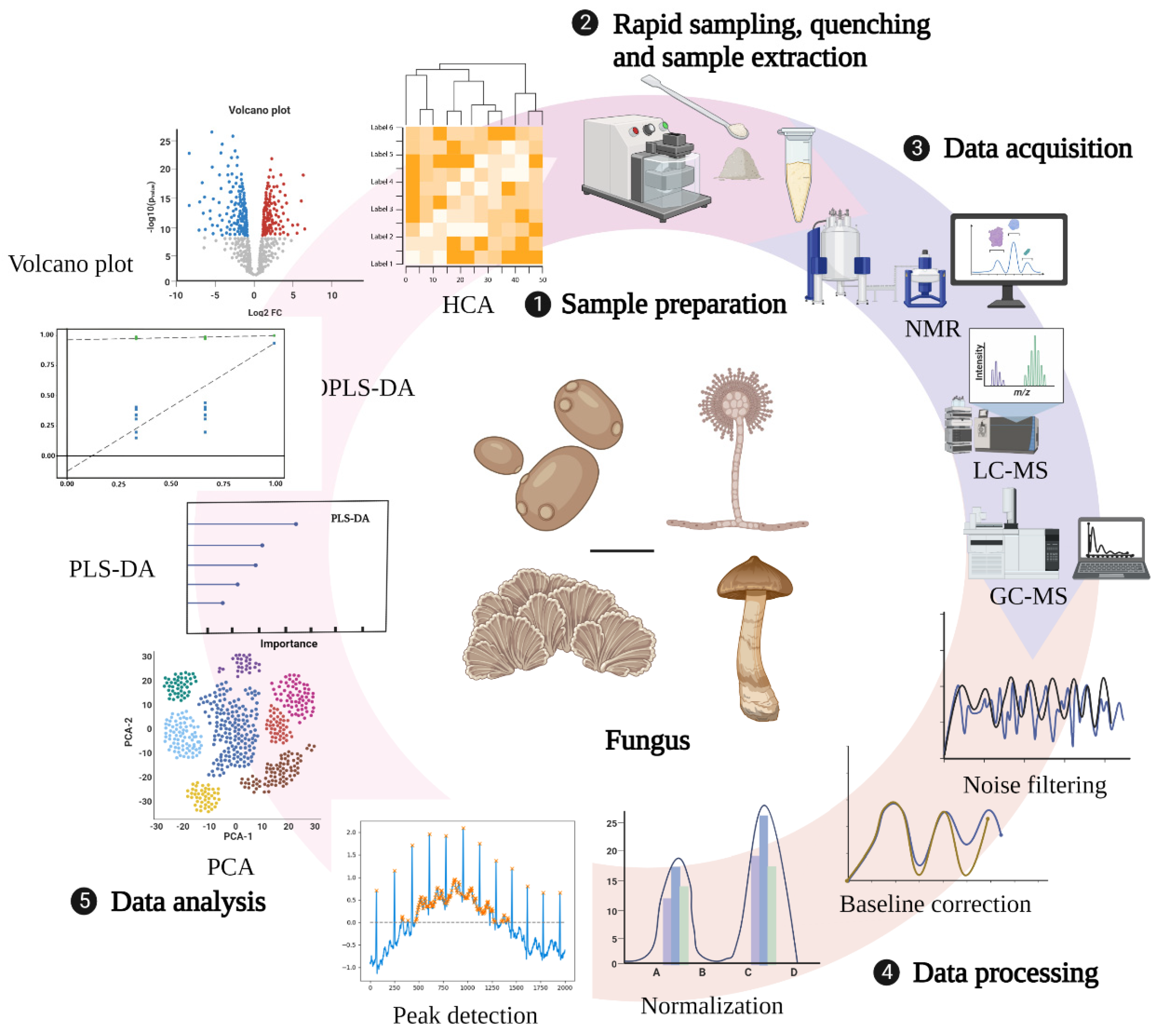

| Species | Techniques | Nos. of Metabolites | Main Metabolites | Involved Pathway | Ref. |
|---|---|---|---|---|---|
| Fungal response to stress | |||||
| Agaricus subrufescens | UHPLC–MS/MS | 38 | Ergosterol, agaritine, pyroglutamic acid, vitamin B3, sphingolipids | [19] | |
| Phanerochaete chrysosporium | GC–MS | 53 | Veratryl alcohol, threonate, and erythronate | [20] | |
| Alternaria sp. MG1 | GC–TOF-MS | 239 | Amino acid, carbohydrate, xenobiotics, and lipid | PPPN biosynthesis pathway | [21] |
| Cryptococcus neoformans | GC–TOF-MS | Amino acids, carbohydrates | Amino acid and carbohydrate metabolism | [22] | |
| Pleurotus ostreatus | LC–Q/TOF-MS | 59 | Sucrose, dextrin, adenine, uracil, L-glutamine, and L-lysine | glutathione metabolism, sphingolipid metabolism, and some amino-acid metabolism | [23] |
| Volvariella volvacea | LC–Q/TOF-MS | 547 | Organic acids, fatty acids, amino acids, carbohydrate metabolites, nucleotides | Amino-acid metabolism, carbohydrate metabolism, the TCA cycle, energy metabolism | [24] |
| Aspergillus aculeatus | GC–MS | 42 | Amino acids, organic acids, sugars, fatty acids, and sugar alcohol | [25] | |
| Aspergillus flavus | LC–MS/MS | 135 | Tricarboxylic acid cycle, amino acid biosynthesis, protein degradation, absorption, mineral absorption | [26] | |
| Aspergillus niger | GC–MS | Mannitol and gluconic acid | Mannitol cycle | [27] | |
| Aspergillus niger | LC–MS/MS | 68 | Triacylglycerol, monoacylglycerol, hydroxy-triacylglycerol | Glycerolipid metabolism | [28] |
| Ganoderma lucidum | GC–MS and LC–MS/MS | 154/70 | L-Malic acid, alpha-hydroxycholesterol, zymosterol, ergosterol | Protein digestion, absorption, purine metabolism, unsaturated fatty acids, fatty-acid biosynthesis, purine metabolism | [29] |
| Cunninghamella echinulata | LC–MS/MS | Protein and amino acid | Purine, amino-acid, TCA, and sugar metabolism | [30] | |
| Schizochytrium limacinum SR21 | GC–MS | 30 | Fatty acids, amino acids, organic acids, carbohydrates, alcohols, squalene, cholesterol | Mevalonate, lipid synthesis, and pentose phosphate pathway | [31] |
| Industrial yeast | GC–MS | 59 | Trehalose, glycerin acid, fatty acids | TCA cycle, fatty-acid synthesis, glycolysis pathway, arginine metabolism, etc. | [32] |
| Discovery of fungal natural products | |||||
| Ganoderma lucidum and Cordyceps sinensis | HPTLC–MS | 6 | Thymine, uracil, adenine, cytosine, guanine and guanosine | [33] | |
| Ophiocordyceps sinensis | UHPLC–Q-TOF-IMS | 345 | Tyrosyl-phenylalanine, 2-phenylethyl beta-D-glucopyranoside and 3′,5′-odimethylmyricetin 3-O-beta-D-2″,3″-diacetylglucopyranoside | [34] | |
| Cordyceps militaris | GC–MS | 39 | Amino acid, nucleosides, organic acids, and sugars | Nucleotide, carbohydrate, and amino-acid metabolism | [35] |
| Ophiocordyceps sinensis and Cordyceps militaris | LC–TOF-MS | 100 | Amino acids, unsaturated fatty acid, peptides, mannitol, adenosine, and succinoadenosine | [36] | |
| Cordyceps sinensis and Cordyceps militaris | LC–MS | 39 | L-Tyrosine, 9,10-dihydroxy-12Z-octadecenoic acid and (−)-riboflavin | Histidine metabolism | [37] |
| Cordyceps militaris | LC–ESI-IT-MS/MS and GC–EI-IT-MS | Soyasaponin, pyroglutamic acid, isoflavone methyl-glycosides | [38] | ||
| Trametes versicolor and Ganoderma applanatum | 57 | N-(4-Methoxyphenyl)formamide 2-O-β-D-xyloside and N-(4-methoxyphenyl)formamide 2-O-β-D-xylobioside | [39] | ||
| Aspergillus oryzae and Zygosaccharomyces rouxii | UHPLC–Q-TOF-MS | 32 | N-Formyl-l-aspartate, imidazoleacetic acid, taurine, glycocholate, phenylpyruvate | Histidine metabolism, phenylalanine, adenosine kinase, phosphatidylserine synthase homo sapiens, phosphatidylethanolamine scramblase | [40] |
| Agaricus bisporus | UPLC–Q-TOF-MS | 40 | Organic acids, trehalose | Fatty-acid biosynthesis, tyrosine metabolism, and citrate cycle | [41] |
| Flammulina filiformis | HILIC–ESI(±)-QTOF-MS, LC–MS/MS | 107 | Melanin, l-dopa (3,4-dihydroxy-l-phenylalanine) | Phenylpropanoid biosynthesis and tyrosine metabolism | [42] |
| Aspergillus terreus | LC–HRMS | 18 | Quinones, isocoumarins, polyketides | [43] | |
| Morchella sp. | UPLC–Q-TOF-MS | 50 | Fatty acids, peptides | [44] | |
| Penicillium restrictum MMS417 | UPLC–IT/TOF-MS/MS | Pyran-2-ones | [45] | ||
| Fungal metabolic engineering | |||||
| Saccharomyces cerevisiae | GC–EI-MS | Geranyl diphosphate, farnesyl diphosphate, geranylgeranyl diphosphate, squalene, lanosterol, and ergosterol | Isoprenoid pathway | [46] | |
| Aspergillus nidulans | LC–MS | Fellutamide B, antibiotic 1656-G, and antibiotic 3127 | [47] | ||
| Aspergillus nidulans | UHPLC–ESI-HRMS | 6 | Orcinol, phenoxyacetic acid, orsellinic acid, monodictyphenone, gentisic acid, and caffeic acid | Glycine, serine, and threonine metabolic pathway, glycolysis, and TCA cycle | [48] |
| Fusarium verticillioides and Streptomyces sp. | LC–ESI-QqQ | 36 | Amino acids, saccharides, nucleotides, organic acids, phenol, lipid, and amine | Protein synthesis, Krebs cycle | [49] |
| Fusarium verticillioides | GC–MS | 46 | Arabitol, mannitol, and trehalose | Fumonisin biosynthesis and trehalose biosynthesis | [50] |
| Fusarium graminearum | LC–MS | 22 | N-Ethyl anthranilic acid, N-phenethylacetamide, tricinolone and tricinolonoic acid, fusarins, zearalenones, and fusaristatin A | [51] | |
| Fusarium graminearum | NMR–GC-FID–MS | 45 | Sugars, amino acids, organic acids, choline metabolites | Inhibiting glycolysis, tricarboxylic acid cycle | [52] |
| Aspergillus nidulans | GC–EI-MS | 86 | Carbohydrates, amino acids, and carboxylic and lipid acids, purines and pyrimidines | Amino-acid and carbohydrate metabolism | [53] |
| Plant–fungal interaction | |||||
| Diaporthe phaseolorum, Trichoderma spirale | NMR | 20 | Threonine, malic acid, and N-acetyl-mannosamine | [54] | |
| Pisolithus tinctorius | NMR, FT-ICR | 61 | Carbohydrates, organic acids, tannins, long-chain fatty acids, monoacylglycerols, gamma-aminobutyric acid (GABA), and terpenoids | [55] | |
| Fusarium verticillioides | UPLC–Q-TOF/MS | Isoflavones, jasmonic acid | Phenylpropanoid, flavone metabolic, | [56] | |
| Armillaria luteobubalina | GC–MS | 117 | Sugars, sugar alcohols, amines, or amino acids | D-Threitol synthesis | [57] |
| Tilletia controversa | LC–MS | 62 | 9-HODE, prostaglandin D3, caffeic acid, pyroglutamic acid, tetracosanoic acid | [58] | |
| Penicillium digitata | UHPLC–Q-TOF/MS | 85 | amino acids, lipids, fatty acids, TCA metabolites, galactose metabolites, carbohydrate metabolites, nucleic acids, amino sugars, and nucleotide sugars | Amino-acid, lipid, fatty-acid, and purine metabolism, and TCA cycle | [59] |
| Trichoderma fungi | HRMAS NMR | γ-Aminobutyric acid, acetylcholine, and amino acids | [60] | ||
| Fungal Species | Analysis Platform | Extraction Method | Data Processing | Achievement | Ref. |
|---|---|---|---|---|---|
| T. harzianum T. aggressivum T. virens T. longibrachiatum T. hamatum T. koningii T. atroviride | LC–ESI-MS-MS | The concentrate was pooled into 100 µL of methanol and filtered through a 0.45 umptf filter | Varian MS Workstation 6.9, Vx Capture 2.1, MetAlign, SIMCA-P+ 12.0, Statistica 7 | Chemical taxonomy based on secondary metabolite profiling was found to be advantageous over other classification methods | [114] |
| Ganoderma lucidum | NMR spectroscopy | CD3OD and D2O (v/v, 1:1), 10 mM sodium phosphate, and 0.025% TMSP were mixed and extracted, followed by centrifugation | Matlab, SIMCA-P version 11.0, Chenomx, and Excel | Development of a method to effectively distinguish between national and even regional sources of G. lucidum cultivation | [116] |
| Rhizoctonia solani | GC/MS | Derivatization in autosampler vials, upon addition of 80 μL of methoxyamine hydrochloride solution (30 °C, 120 min) and 80 μL of MSTFA (37 °C, 90 min) | ACD/Spec Manager v.12.00, mass spectra matching the National Institute of standards and Technology Library, SIMCA-P 12.0 | Characterization and identification of an isolate of Rhizoctonia solani | [117] |
| Aspergillus | MALDI-TOF-MS | Bead disruption sample pretreatment followed by centrifugation | BioRad data processing suite | Can be used to unambiguously identify members of the genus Aspergillus at the species and strain level | [118] |
| Candida species, Aspergillus species, and other yeast genera | MALDI-TOF-MS | Washed yeast cells were fixed by suspension in 50% methanol/water (v/v) or stored at 4–6 °C for 45 days for subsequent comparative analysis | External alignment was performed using cytosolic picolinic acid A, etc.; MALDI mass spectra were processed using “Data Explorer” (Applied Biosystems), and data were processed in MATLAB | Was used to identify yeast and group strains, as well as follow morphogenesis of C. albicans | [119] |
| Epichloë festucae | LC–HR-MS/MS | MTBE, methanol, and water were extracted in two phases, dissolved in 60 µL of methanol/acetonitrile/water (v/v/v, 1:1:12), and centrifuged | The datasets were processed with markerlynx XS for maslynx v.4.1, and the software suite Marvis did the subsequent processing | A genetic approach combined with tandem mass spectrometry was used to identify novel products of secondary metabolite gene clusters and to discover novel Leu/Ile glycoside metabolites | [120] |
| Wide edible mushrooms | UHPLC–QE Orbitrap/MS/MS | Chloroform and methanol are mixed (2:1 v/v), then centrifuged | SPSS 16.0 statistical analysis, xcalibur 4.0, ms-dial 4.36, and lipidmaps for identification and quantification of lipids, SIMCA 14.1, metaboanalyst 4.0 follow-up analysis | It is helpful for improving the sensitivity, reproducibility, and accuracy of trace-level analysis of triterpenoids in complex biological samples | [121] |
| Ganoderma lucidum mycelium | UPLC–ESI-HR-QTOF-MRM | Methanol post-extraction filtration | Masslynx 4.1 performed data acquisition, targetlynx quantification, and SPSS 17.0 | Highly precise identification and quantification of triterpenoids present in trace amounts in mycelia of G. lucidum | [122] |
| Structure | Molecular Weight | Molecular Formula | Compound Name | Reference |
|---|---|---|---|---|
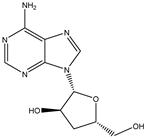 | 251.2460 | C10H13N5O3 | Cordycepin | [34] |
 | 460.3915 | C22H22O9 | Daidzein 7-O-beta-D-glucoside 4-O-methylate | [38] |
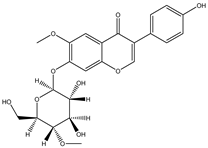 | 460.4350 | C23H24O10 | Glycitein 7-O-beta-d-glucoside 4″-O-methylate | [38] |
 | 446.4080 | C22H22O10 | Genistein 7-O-beta-d-glucoside 4″-O-methylate | [38] |
 | 446.4080 | C22H22O10 | Genistein 4′-O-beta-d-glucoside 4″-O-methylate | [38] |
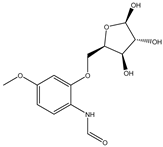 | 299.2970 | C13H17NO7 | N-(4-Methoxyphenyl)formamide 2-O-beta-D-xyloside | [39] |
 | 166.1760 | C9H10O3 | 3-Phenyllactic acid | [39] |
 | 168.1480 | C8H8O4 | Orsellinic acid | [39] |
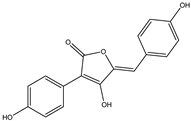 | 296.2780 | C17H12O5 | Aspergillide B1 | [43] |
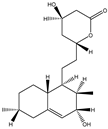 | 322.4450 | C19H30O4 | 3a-Hydroxy-3, 5-dihydromonacolin L | [43] |
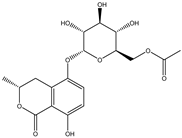 | 398.3640 | C18H22O10 | 5-Hydroxymellein | [129] |
 | 230.2630 | C14H14O3 | Diorcinol | [129] |
 | 208.2130 | C11H12O4 | Botryoisocoumarin A | [129] |
 | 178.1870 | C10H10O3 | Mellein | [129] |
 | 194.1860 | C10H10O4 | 3-Hydroxymellein | [129] |
 | 207.2515 | C15H11O+ | Anthocyanins | [130] |
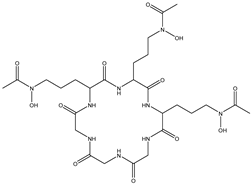 | 687.7080 | C27H45N9O12 | Desferriferrichrome | [44] |
 | 158.1530 | C7H10O4 | 5,6-Dihydro-6s-hydroxymethyl-4-methoxy-2h-pyrene-2-one | [45] |
 | 230.2600 | C11H18O5 | (6S, 1′r, 2′s)—ll-p880 β | [45] |
 | 228.2240 | C11H16O5 | 5,6-Dihydro-4-methoxy-6S-(1′S, 2′S-dihydroxy pent-3′ (E)-enyl)-2H-pyran-2-one | [45] |
 | 126.1110 | C6H6O3 | 4-Methoxy-6-(1′R, 2′S-dihydroxy pent-3′ (E)-enyl)-2H-pyran-2-one | [45] |
 | 126.1110 | C6H603 | 4-Methoxy-2H-pyran-2-one | [45] |
Publisher’s Note: MDPI stays neutral with regard to jurisdictional claims in published maps and institutional affiliations. |
© 2022 by the authors. Licensee MDPI, Basel, Switzerland. This article is an open access article distributed under the terms and conditions of the Creative Commons Attribution (CC BY) license (https://creativecommons.org/licenses/by/4.0/).
Share and Cite
Li, G.; Jian, T.; Liu, X.; Lv, Q.; Zhang, G.; Ling, J. Application of Metabolomics in Fungal Research. Molecules 2022, 27, 7365. https://doi.org/10.3390/molecules27217365
Li G, Jian T, Liu X, Lv Q, Zhang G, Ling J. Application of Metabolomics in Fungal Research. Molecules. 2022; 27(21):7365. https://doi.org/10.3390/molecules27217365
Chicago/Turabian StyleLi, Guangyao, Tongtong Jian, Xiaojin Liu, Qingtao Lv, Guoying Zhang, and Jianya Ling. 2022. "Application of Metabolomics in Fungal Research" Molecules 27, no. 21: 7365. https://doi.org/10.3390/molecules27217365
APA StyleLi, G., Jian, T., Liu, X., Lv, Q., Zhang, G., & Ling, J. (2022). Application of Metabolomics in Fungal Research. Molecules, 27(21), 7365. https://doi.org/10.3390/molecules27217365








